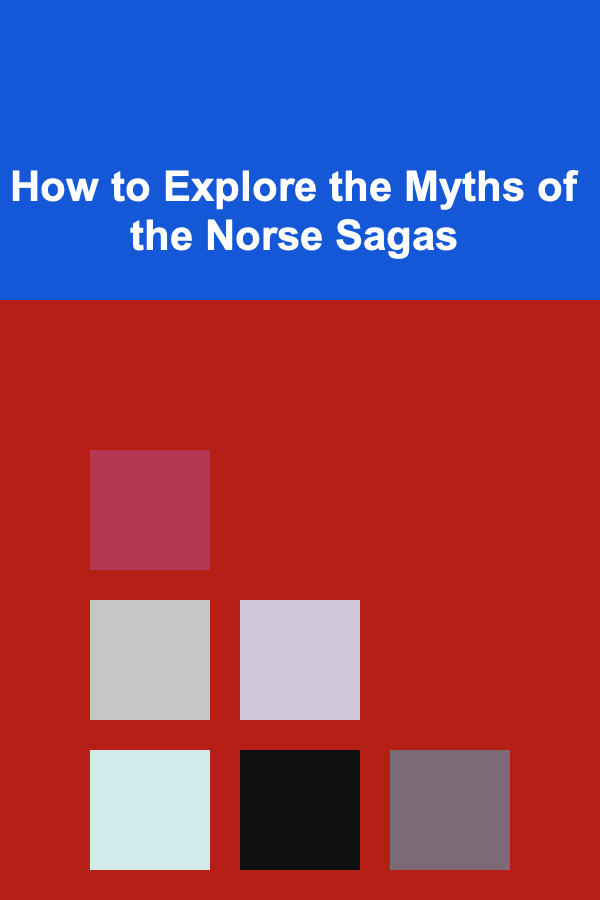
How to Explore the Myths of the Norse Sagas
ebook include PDF & Audio bundle (Micro Guide)
$12.99$6.99
Limited Time Offer! Order within the next:

The Norse sagas are an essential part of world literature, offering a fascinating glimpse into the ancient Scandinavian world. Rooted in oral tradition and later transcribed into written form, these sagas tell the stories of gods, heroes, and the very fabric of Norse mythology. From tales of thunderous battles and tragic love stories to intricate moral lessons and wisdom, the myths found in the Norse sagas continue to captivate readers around the world.
This article explores how one can delve into the myths of the Norse sagas, offering guidance on understanding their origins, themes, characters, and cultural significance. We'll take a deep dive into the texts, explore the intersection of history and legend, and look at how modern interpretations continue to evolve.
Understanding the Norse Sagas
Before we delve into the specifics of exploring the myths of the Norse sagas, it's important to understand what these sagas are and where they come from. The Norse sagas are a collection of epic narratives from medieval Iceland and Scandinavia. They combine history, mythology, and folklore, and were passed down through generations by oral tradition before being written down in the 13th and 14th centuries. Most of these sagas were composed in Old Norse, the language of the Vikings.
The sagas can be categorized into several types:
- Mythological Sagas: These include stories of gods and goddesses, such as the tales of Odin, Thor, and Loki.
- Heroic Sagas: These focus on legendary warriors and their feats, often involving revenge, quests, and battle.
- Family Sagas: These recount the lives and struggles of real or semi-real historical figures, typically set in Iceland's early settlement period.
The oldest and most well-known of these sagas are those that center around the gods, such as the Poetic Edda and the Prose Edda, which were written by the Icelandic scholar Snorri Sturluson in the 13th century. These sagas not only recount myths and heroic deeds but also offer insight into the social, political, and cultural fabric of the time.
The Role of Myth in Norse Society
To fully appreciate the Norse sagas and their myths, one must first understand the role of mythology in the Viking Age society. Norse mythology was not just a collection of stories told for entertainment; it was a central part of religious and cultural life. The gods, with their immense power and tragic flaws, were seen as guiding figures, representing different aspects of human experience.
Polytheism and the Pantheon of Gods
The Norse pantheon is vast, with a multitude of gods, goddesses, and other mythological beings. The most famous of these gods are Odin, Thor, and Loki, but there are many others who play key roles in the sagas. These include Freyja, the goddess of love and fertility, and Tyr, the god of war and justice.
The gods were believed to interact with humans and other creatures in both the mortal and divine realms. They were seen as both distant and intimately involved in the lives of mortals. The world of the gods is intricately connected with the mortal world through events such as the creation of the universe, the role of fate, and the ultimate destruction and rebirth of the world in Ragnarok.
Cosmology and the Nine Worlds
The Norse cosmos is structured into nine worlds, each of which is connected by the great tree Yggdrasil. These worlds include realms like Asgard, the home of the gods; Midgard, the world of humans; and Jotunheim, the land of the giants. Each world plays a specific role in the mythology and the sagas, and understanding their relationships provides insight into how the Norse viewed their place in the universe.
The mythology surrounding these worlds, particularly the events leading up to Ragnarok (the end of the world), is central to the Norse sagas. Ragnarok is prophesied as a catastrophic event where many gods, including Odin, Thor, and Loki, meet their fates. This apocalyptic vision of the future reflects the Norse belief in the cyclical nature of time and the inevitability of destruction and rebirth.
Exploring Themes in the Norse Myths
Norse mythology is rich with profound themes that explore human nature, fate, honor, and the natural world. These themes are not only present in the myths themselves but also woven throughout the sagas. Here are a few key themes to explore in the Norse sagas:
1. Fate and Free Will
One of the most dominant themes in Norse mythology is the tension between fate and free will. The concept of wyrd (fate) is deeply embedded in Norse thought. The gods themselves are subject to fate, and many sagas emphasize the inevitability of death and destruction.
For example, the story of Ragnarok highlights how even the mightiest gods cannot escape their destined end. However, the idea of fate does not eliminate personal responsibility or choice. Characters in the sagas often face difficult decisions, and their actions can alter the course of their lives, even if they cannot avoid their ultimate destiny.
2. Honor and Revenge
Another significant theme in the sagas is the importance of honor and the pursuit of vengeance. The Norse warriors, known as Vikingr (Vikings), were governed by a strict code of honor, and many sagas revolve around acts of revenge or justice for wrongdoings. This code was seen as a way of maintaining personal dignity and social order.
In sagas like Njáls Saga, revenge plays a central role, with characters avenging the death of loved ones or the violation of their honor. These acts of vengeance, however, often lead to a cycle of violence that ends in tragic outcomes.
3. The Heroic Ideal
The Norse sagas also celebrate the heroic ideal, which is reflected in the figures of legendary heroes such as Sigurd, the dragon slayer. Heroes in these sagas are typically brave, strong, and relentless in their pursuit of glory. They often face insurmountable odds, and their stories are filled with trials that test their courage, loyalty, and strength.
However, these heroes are also flawed, and their journeys are not without personal sacrifices. Their stories reflect the Norse understanding that heroism is complex and comes with both rewards and consequences.
4. Nature and the Supernatural
Nature and the supernatural are deeply intertwined in Norse mythology. The gods themselves are closely connected to the forces of nature, and much of the mythology is concerned with the battle between the gods and the forces of chaos represented by the giants.
The sagas often include mystical creatures such as dragons, trolls, and spirits, which add to the atmosphere of the stories and emphasize the dangers of the natural world. These creatures are not just obstacles to be overcome; they often embody the untamed, unpredictable forces of nature that the Norse viewed as a constant challenge to human survival.
Key Texts for Exploring Norse Myths
To fully engage with the myths of the Norse sagas, it's important to familiarize yourself with the primary texts. Below are some essential works to explore:
1. The Poetic Edda
The Poetic Edda is one of the most important collections of Norse mythology, containing poetic versions of many of the gods' stories. It includes accounts of the creation of the world, the adventures of gods like Odin and Thor, and the events leading up to Ragnarok. The Poetic Edda is composed of various poems that are considered foundational texts in Norse literature.
2. The Prose Edda
Written by Snorri Sturluson, the Prose Edda is a key source of Norse mythology. It provides a more structured and accessible version of the myths found in the Poetic Edda. Snorri's work is a mixture of mythology, folklore, and ancient Icelandic traditions, offering a comprehensive guide to the gods, heroes, and the structure of the Norse universe.
3. The Sagas of Icelanders
The Sagas of Icelanders are a collection of medieval Icelandic prose narratives. These sagas often include elements of Norse mythology but are also historical accounts of Icelandic families and their struggles. Many of these sagas, such as Njáls Saga and Egils Saga, feature heroic figures and themes of vengeance, honor, and fate.
4. The Saga of the Volsungs
This saga is one of the most famous of the Norse heroic sagas, telling the story of the Volsung family, including the hero Sigurd, who slays the dragon Fafnir. The Saga of the Volsungs is rich in themes of fate, revenge, and the tragic consequences of heroism.
How to Approach the Study of Norse Myths
Exploring the Norse sagas can be both a rewarding and challenging endeavor. Here are some strategies to help you get the most out of your study:
1. Read Multiple Versions
Because the Norse sagas were passed down through oral tradition before being transcribed, there are multiple versions of many stories. Reading different interpretations and translations can help you understand the nuances of the myths.
2. Contextualize the Myths
To truly grasp the meaning of the sagas, it's essential to understand the historical and cultural context in which they were created. Researching the Viking Age, the social structure of Norse society, and the influence of Christianity on the Norse worldview will help you appreciate the complexities of the sagas.
3. Analyze Themes and Symbols
Take time to analyze the recurring themes, symbols, and motifs in the sagas. This can deepen your understanding of the underlying messages and values in the stories. For example, consider the symbolism of Yggdrasil, the world tree, and how it represents the interconnectedness of all beings in Norse cosmology.
4. Join Discussions and Communities
Participating in discussions with others who are interested in Norse mythology can offer new perspectives and insights. Joining online forums, reading blogs, or attending lectures can help expand your knowledge and deepen your understanding of the sagas.
Conclusion
Exploring the myths of the Norse sagas is an enriching journey that offers a deep connection to the ancient world of the Vikings. By understanding the role of mythology in Norse society, delving into the themes and characters of the sagas, and reading key texts, you can gain a deeper appreciation for these timeless stories. Whether you are a scholar, a casual reader, or simply someone with an interest in ancient cultures, the Norse sagas provide a rich and complex world to explore, one that continues to inspire and captivate audiences today.
Reading More From Our Other Websites
- [Home Pet Care 101] How to Introduce a New Pet to Your Existing Fur Family: A Step-by-Step Guide to Harmony
- [Whitewater Rafting Tip 101] From Rookie to Rapids: Group Rafting Tips for Every Skill Level
- [Personal Care Tips 101] How to Use Brow Gel to Create Feathered Brows
- [Home Security 101] How to Keep Your Security System Updated and Maintained
- [Needle Felting Tip 101] From Lamb's Wool to Alpaca: How Different Fibers Affect Felting Texture and Strength
- [Rock Climbing Tip 101] Avoiding Tendon Injuries While Training Finger Strength
- [Home Security 101] How to Keep Your Home Safe During the Summer Months
- [Personal Care Tips 101] How to Use a Hair Mask to Nourish Dry, Colored Hair
- [Soap Making Tip 101] Creative Add-Ons: Herbs, Scents, and Colors That Shine in Tallow Soap
- [Personal Investment 101] How to Diversify Your Portfolio: Protecting Your Investments

How to Create a Functional Space Saving Utility Room
Read More
How to Create a Job Interview Checklist for Managing Time and Location
Read More
Money-Saving Challenges: Creative Ways to Cut Costs and Save More
Read More
What Techniques Can Help You Organize Your Workspace at Home?
Read More
10 Tips for Bankroll Management in Tournaments
Read More
How to Use Satellite Data to Track Storms
Read MoreOther Products

How to Create a Functional Space Saving Utility Room
Read More
How to Create a Job Interview Checklist for Managing Time and Location
Read More
Money-Saving Challenges: Creative Ways to Cut Costs and Save More
Read More
What Techniques Can Help You Organize Your Workspace at Home?
Read More
10 Tips for Bankroll Management in Tournaments
Read More